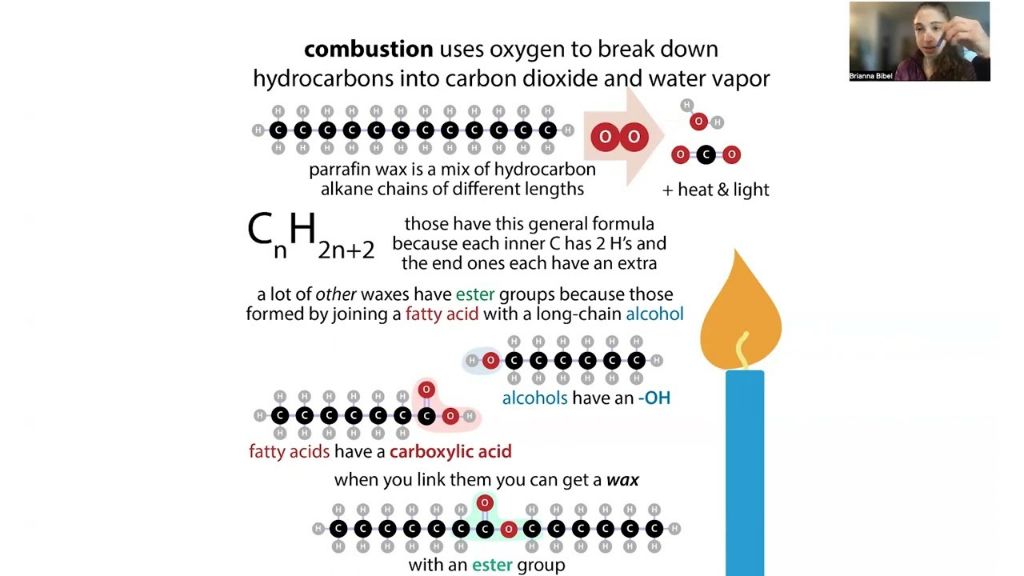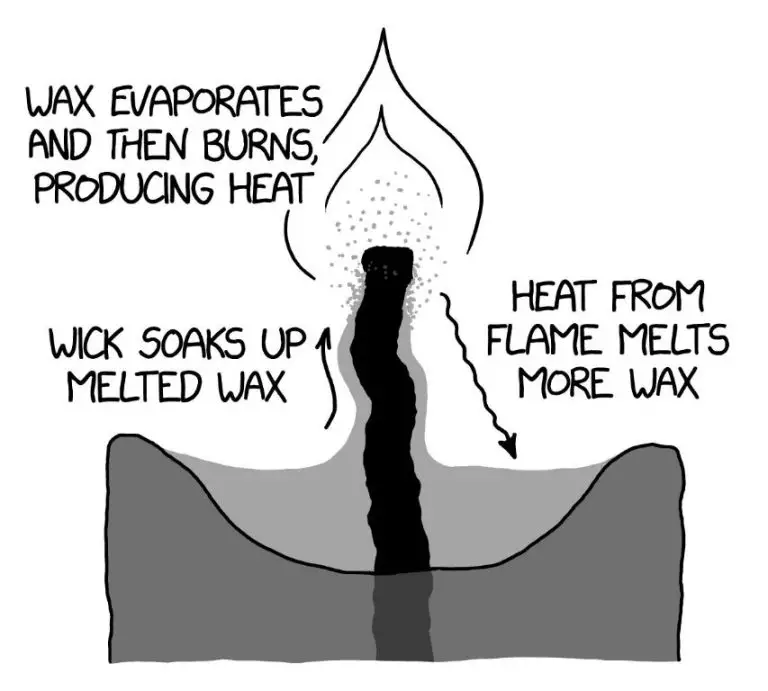Can A Candle Burn Without Leaving Wax?
Burning candles create a warm, calming ambiance and can fill a room with delightful scents. But have you ever wondered what exactly happens to the wax as the candle burns down? Where does all that wax go, and is it possible for a candle to burn without leaving any wax behind?
This article will explore the science behind how candles burn, whether it’s possible for them to burn completely without leftover wax, and alternatives that allow you to enjoy flickering flames without creating any waste at all.
We’ll delve into candle wicks, wax chemistry, safety considerations, and more. Read on to uncover some illuminating facts about candle burning!
What is a Candle?
A candle is a small device made from a wax-like substance called fuel, which holds a wick that is lit to provide light. According to Quora, “A candle is made of wax, a solid hydrocarbon, (an organic solid) and a wick” (source). The main components of a typical candle are:
- Wax – This is usually paraffin wax, a byproduct of petroleum refining, but can also be beeswax or vegetable-based waxes like soy, palm, or coconut wax (source). The wax melts and vaporizes to fuel the flame.
- Wick – Typically a braided cotton cord that runs through the center of the wax. The wick absorbs liquid wax to deliver fuel to the flame.
- Fragrance – Essential oils or synthetic fragrances added for scent. Scented candles contain about 1-5% fragrance oil.
These three key components allow candles to provide illumination and aroma when lit.
How Does a Candle Burn?
The combustion process enables a candle to burn.
For a candle to burn, it relies on the wick to draw up melted wax via capillary action. The wax gets heated by the flame and turned from a solid state to a liquid state. As the liquefied wax gets drawn up the wick, it vaporizes and combusts when it meets the flame.
The candle wick acts as a fuel delivery system. It soaks up the melted wax and brings it close to the flame so it can vaporize and burn. The wick essentially regulates the fuel supply to the flame. As the wax vaporizes, the wick chars and forms a mushroom top, helping keep the wick upright and exposed to the flame. Without the wick continuously bringing wax to the flame, the candle would not be able to burn.
The wax itself acts as the fuel source. Different types of waxes, such as paraffin, soy, or beeswax, have different melting points and burn properties. The wax composition impacts how the melted wax is drawn up the wick and how quickly and cleanly it combusts.
Oxygen enables the vaporized wax to ignite when it meets the flame. As the wax combusts, it produces heat and light. The candle flame provides the ignition source to keep the wax burning as long as there is adequate oxygen and wax supplied via the wick.
So in summary, the main components enabling a candle to burn are the wick drawing up the melted wax, the wax acting as fuel, the flame providing ignition, and oxygen allowing combustion.
Does Burning Wax Disappear?
When a candle burns, the wax does not simply disappear into thin air. The wax goes through a chemical change in a process called combustion. As the candlewick melts the wax, the liquid wax is drawn up the wick via capillary action. The heat from the flame vaporizes the liquid wax into a hot gas that mixes with oxygen in the air. This gas-oxygen mixture ignites in the flame, generating heat, light, water vapor, and carbon dioxide. The carbon atoms in the wax combine with oxygen atoms from the air to produce carbon dioxide, while the hydrogen atoms combine with oxygen to form water vapor. So the wax is transformed into gaseous products through combustion, rather than disappearing.
The visible flame that you see is actually hot gases being emitted during this chemical reaction. The wax itself does not rise into the air, but rather the gases produced when the wax burns mix with air and create the flame. This is why you do not see solid bits of wax floating in the flame. The wax undergoes a chemical change from solid to gas within the candlewicks.
Therefore, the wax from a burning candle does not disappear, but is chemically converted into hot gases, water vapor, and carbon dioxide. The wax molecules break down in the flame through combustion and reform into different gaseous molecules that rise into the air. The wax mass is conserved, but its chemical composition changes during burning.

Wickless Candles
Wickless candles are designed to melt and release fragrance without needing a wick (Scentsy Unveils New, Trend-Defining Fragrances). These candles typically have scented wax or oils pooled into decorative containers or shapes. The wax or oil is formulated to melt at low temperatures from the heat of the surrounding environment or from an external heat source like a lightbulb or tealight candle underneath. As the wax liquefies, fragrant essential oils are released into the air. With no wick, there is no actual flame or smoke. The wax is designed not to completely disappear or evaporate, leaving the fragrance carrier intact within the container. This allows the candle to be reused by re-solidifying the wax or adding more wax refills.
Popular varieties of wickless candles include scented wax tarts for an electric wax warmer, aroma light bulbs, candle wax refills for dish candles, and wax melts for a scented oil burner. These provide flameless and smokeless options to enjoy candle scents. However, lacking a true flame, they do not provide the visual ambience or experience of a traditional wick candle.
Flameless Candles
Flameless candles create the visual effect of a real burning candle without an open flame. Instead of melting wax to fuel a live flame, flameless candles rely on battery-powered LED lights to mimic the look and ambiance of a traditional candle (How Scented Flameless Candles Work – Experts). These candles use plastic, dyed wax, paraffin wax, or other materials to form the candle body and diffuse light up through the wax. Underneath the mock wax body, LED bulbs produce a flickering flame effect. The light casts upward and reflects off the wax interior to give the illusion of a burning candle (How Do Flameless Candles Work?).
Some flameless candles also include fragrance technology to release scents. The LED bulbs heat scented wax or oils in a cartridge, dispersing aromas into the air. Timer and remote control functions allow users to automate and control flameless candles for customizable ambiance. With no open flames or melting wax, flameless candles provide atmospheric lighting safely and cleanly.
Other Wax-Free Options
There are a few popular alternatives to wax candles that provide lighting and fragrance without melting wax:
Reed Diffusers
Reed diffusers distribute fragrance through the evaporation of essential oils in a bottle. The oil is absorbed by reeds which disperse the scent. Pros of reed diffusers include providing continuous fragrance for months and no need to light flames. Cons are that they don’t provide ambient lighting and some find the scent too strong or overpowering in small spaces (Candle Alternatives: Other Ways to Bring Fragrance and Ambiance to Your Home).
Essential Oil Diffusers
Essential oil diffusers distribute essential oil molecules into the air to scent a room. They provide continuous fragrance without open flames. Drawbacks are they require refilling with water and don’t provide mood lighting (6 Candle Alternatives that Don’t Feel Like a Downgrade).
Incense
Incense infuses spaces with fragrance from slowly burning resins or herbs. It provides ambiance and scent without melting wax. Cons are the scents can be overpowering and incense produces smoke (6 Candle Alternatives that Don’t Feel Like a Downgrade).
Safety Considerations
When burning a candle, it’s important to keep fire safety in mind. According to the U.S. Fire Administration, candles are an open flame that can easily ignite combustible materials (https://www.usfa.fema.gov/prevention/home-fires/prevent-fires/candle/). Follow these tips:
- Keep candles at least 12 inches away from anything that can burn.
- Avoid leaving burning candles unattended.
- Make sure candles are on stable, heat-resistant surfaces.
- Keep candles out of reach of children and pets.
- Trim wicks to 1⁄4 inch before lighting.
- Always use a candleholder that is heat resistant.
- Don’t burn a candle all the way down – stop usage before 1/2 inch of wax remains.
- Extinguish candles when leaving a room or going to sleep.
Some candles also release toxins like lead, benzene, and toluene when burned (https://www.nfpa.org/education-and-research/home-fire-safety/candles). Make sure to ventilate rooms when burning candles and choose unscented, toxin-free options whenever possible.
Environmental Impact
The environmental impact of candles depends largely on the type of wax used. Paraffin wax, the most common candle wax, is a petroleum byproduct, creating emissions when refined that are as bad for the environment as the emissions from burning fuel in vehicles (https://thebiggaycollective.com/blogs/news/environmental-impact-of-candles). Additionally, paraffin wax releases compounds like toluene and benzene into the air when burned, which can be hazardous to human health.
More natural waxes like soy, beeswax, and vegetable-based waxes have less of an environmental impact during production. Beeswax and soy wax, for example, are renewable resources that don’t require extensive chemical processing. However, there are still environmental considerations around sourcing these waxes ethically and sustainably (https://www.sweetashome.nz/post/are-candles-bad-for-the-environment-which-type-of-wax-candle-is-the-safest-for-the-environment).
Proper disposal of candles is also important to reduce environmental impact. Allowing wax to get into waterways can be detrimental to marine life. The best disposal method is to allow the candle to fully solidify before putting it in the trash. Recycling programs for candle wax also exist in some areas (https://www.conserve-energy-future.com/are-candles-bad-for-environment.php).
Conclusion
In summary, while traditional candles require wax to burn, there are types of candles that can burn without leaving behind wax residue. Wickless candles utilize candle warmers to melt wax which is then absorbed into the candle holder. Flameless candles use LED lights to mimic the look of a flame without any real fire or wax. Alternatives like wax melts and essential oil diffusers also provide candle-like experiences without burning wax. However, they don’t technically meet the definition of a candle.
So to answer the initial question – yes, certain candle variants can burn without wax. However, the traditional structure of a wick and wax is still the most common and effective way for a candle to burn. While wax-free options offer benefits, like being safer and cleaner, they may not provide the full sensory satisfaction that burning wax candles do. Ultimately, if minimizing wax is a priority, there are candle alternatives available – but true candles rely fundamentally on the burning of wax to function.




